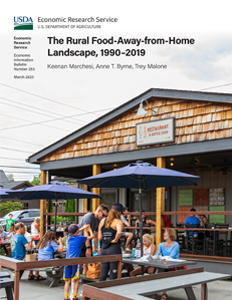The Rural Food-Away-from-Home Landscape, 1990–2019
- by Keenan Marchesi, Anne T. Byrne and Trey Malone
- 3/29/2023
Overview
Focusing on U.S. nonmetropolitan (nonmetro) counties as of 2019 and over the past 30 years since 1990, ERS examined the FAFH landscape across the United States—i.e., the availability of restaurants, cafeterias, food trucks and the like outside of the home. We focused on trends and differentiating features in FAFH access across the metropolitan divide and across the rural-urban continuum, using annual establishment-level data from the National Establishment Time Series (NETS) dataset. We found FAFH is generally less available in the most nonmetro counties. We also found, among the FAFH options in those rural nonmetro counties, there is a prevalence of national chain restaurants. However, this result does not hold uniformly. Counties with recreation as their primary industry tended to offer more FAFH options than rural counties with other leading industries, including nonmetro counties. Furthermore, there has been an expansion of FAFH in nonmetro counties, including the most rural nonmetro counties, led by growth in limited-service restaurants. These results could have implications for food access, overall health, and other consumer food metrics as the results relate to the food environment because FAFH generally offers a different nutritional profile than food at home and may provide additional convenience.
Errata: On May 5, figures 2a, 2b, 7, 12a, and 12b were updated with data for Honolulu County, Hawaii. No other figures or text were affected.
Errata: On August 17, figures 2a, 2b, 7, 12a, and 12b were updated to reflect the non-metro status for Aleutians West, Alaska. No other figures or text were affected.
Download
-
Entire report
Download PDF -
Report summary
Download PDF

